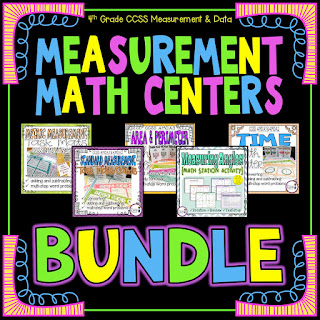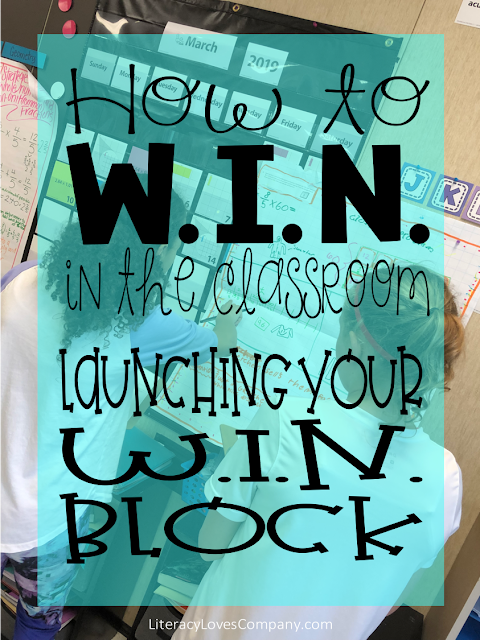Welcome to the sixth and final post in my W.I.N. block series! I hope the first five have been helpful in getting you inspired and organized to start a W.I.N. block in your own classroom.
W.I.N. which stands for What I Need is a time during your class schedule that is set aside for the purpose of meeting individual student needs. During this time you are providing students with intervention, engagement, and/or enrichment activities and instruction based on each student's need.
In the previous five posts I explained and gave ideas for what W.I.N. time is, organizing student groups, planning for station activities, managing station and teacher materials, and keeping kids accountable during their W.I.N. time. Today I am going to share with you some ideas and some insight into how I launched my W.I.N. block with my math class.
BEFORE DAY 1
Before your launch day, make sure you have everything prepared:
- Student groups are set based on data (pretests, other assessments, observations, etc.)
- Stations with appropriate activities are ready.
- Your "Teacher Time" lessons are prepared.
- Student folders are prepped and at the station they are assigned to the first day.
- Student "Weekly W.I.N. Reports or Trackers" are printed and ready.
- Your W.I.N. Block board is up and student groups and other information are posted.
- Know what your signal will be to let students know W.I.N. time is over. I use a small chime.
On the first day of W.I.N., I gathered my students around the W.I.N. board.
They were curious about the information and names on the board, so it was easy to keep their attention. I explained what W.I.N. time was and why we would be using a portion of our math time to participate in it. I have a diverse group of learners in my math class, so the idea of different activities and opportunities was exciting for them. My gifted learners were excited to be challenged in different ways and my struggling students knew that they would be practicing skills and concepts that would help them start to grasp the material we were working on.
 |
| Both of these posters are available to download on the first post in this series. |
After I had explained what W.I.N. time was, I went over the expectations for their work and behavior.
On this first day, we did not actually do W.I.N. It was our practice day. After going over expectations, the students and I traveled from station to station as I explained each activity they would participate in. I have found that it is important to always locate each station in a specific location. Student are then able to easily know that when they are assigned to "Teacher Time" they meet on the carpet, or if they are working on "Targeted Practice" they always meet at the round table. The more consistent you can be, the more smooth the transition into W.I.N. time will be for you and your students.
It is important that students understand the plan for when they are at their station.
1. Students should read the directions for their activity and make sure everyone in the group is clear about what the expectation is. If you are using the Tracker, students should read and know what the question is that they will be answering at the end of their W.I.N. time.
2. Students should begin working on their task. This might be a game, a worksheet, a computer task, or other activity.
3. There should be a plan for early finishers. What can they do? I have a bin of math picture books, multiplication practice sheets, flash cards, etc. for students to grab if they finish. Make sure to explain this to students. It would be a good idea to make a menu of what students can do and hang it on your W.I.N. board.
4. What should students do if they have a question or get stuck and you, the teacher, isn't available to help? Students should rely on each other and work together to be problem solvers. They should not interrupt the "Teacher Time" station unless it is an emergency.
5. At the end of time, when the signal is given, students will clean up their station so that it is ready for the next group.
6. Students will answer their station question on their W.I.N. tracker and put it back in their folder.
7. All folder should be placed in the station bin (or if you want to collect them each day, explain to students where they should put their folders.)
8. All station bins should be put away. Make sure your students know where they should put the bins.
On this first day, we did a practice run. I explained to students that we were going to "pretend" to do W.I.N. so that we were prepared to start it the next day. I compared it to having fire drills... we practice so we know what to do.
My W.I.N. time is the first 30 minutes of my math block. I had students leave the room and then come in pretending like it was the beginning of class. Students came in, looked at the board, and then went to their stations. I monitored and helped students who were lost or didn't know what to do. Students went to their stations, got out the direction sheets and read the directions with their group members. Afterward, they pretended to do the work. This whole time I am walking around and helping students. After about 1 minute, I rang the signal bell. Students cleaned up their stations, and then pretended to write on their tracker. I rang the bell again and one student put the bin away.
At the end of the practice, hold a question and answer session. If the practice didn't go smoothly, go over what the struggles were and clarify expectations once again. It is always okay to hold another practice session.
THE NEXT DAY
The next day is the official start to W.I.N. time. Make sure that stations are out in their designated space. When students come in the door, remind them that today they will be doing W.I.N. time. Today you will be meeting with your "Teacher Time" group, so you will not be able to monitor your whole class the whole time, but I always keep an eye out for groups that are off task or students who look like they are unsure what to do. If this happens, I give my group a problem to work on, or a quick task to do like "Explain to a partner how to do this problem." then I quickly check in on the student or group in need of assistance.
At the end of time and maybe a little early, give students the signal to clean up and write in their tracker. After all stations are cleaned up, ask students what went well today and what they have questions about. I would do this daily for the next week or so as students are getting use to this new classroom routine. It is important to listen to their questions and feedback.
AFTER THE LAUNCH
Always be aware of how your W.I.N. block is running. If there is something not quite working, don't be afraid to stop and adjust. My class was having a terrible time transitioning quietly into class and beginning W.I.N. time. This had been a problem all year, even before we started this new routine. To draw attention to the issue and to give students a challenge, I held a meeting with them. I explained my feelings on the problem and then introduced them to a quick incentive chart.
 |
| Follow Literacy Loves Company on Instagram and Facebook where I share more of my everyday classroom ideas! |
When I introduced it, the prize was covered. At the end of each day, we discussed our goals and then, if they had reached the goal, we would take the sticky notes off of the sheet. Little by little the prize was revealed. It was intriguing to the students and a fun way for students to work on transitioning and staying on task.
My W.I.N. block rounds last 5-6 days. It then takes me a couple of days to re-assess and plan for the next round. During this two days, I usually have all my students working on their iReady lessons. If you have access to IXL or another online program, this might be an option for you. You could also put out different math review games, task cards, etc. to practice until your next round of W.I.N. is ready. I'm sure there are people who are able to get their rounds ready back-to-back, I'm just not one of them. :)
In order for your W.I.N. time to run smoothly, it is important to spend the time at the beginning setting up the routine, explaining the expectations, and practicing.
Well, that's it! As you start your own W.I.N. time, remember to be flexible. Sometimes things don't work out the way you planned and you need to be willing to make changes. Once you get the kinks ironed out and the students trained on the routine, the time you've put aside to give students what they need will be worth every minute!
Thank you for visiting Literacy Loves Company and following along as I shared my experience and advice for setting up a W.I.N. time in your classroom. Please be sure to check out the previous posts and get the free downloads.
Below you will find some links to FREE math station activities from my TeachersPayTeachers store.
To see all Literacy Loves Company math resource click HERE.
Until next time!

Thank you for visiting Literacy Loves Company and following along as I shared my experience and advice for setting up a W.I.N. time in your classroom. Please be sure to check out the previous posts and get the free downloads.
Below you will find some links to FREE math station activities from my TeachersPayTeachers store.
 |
| Students construct and solve subtraction equations to beat their opponents to the finish line! |
 |
| Practice with number lines and tape diagrams. |
 |
| A plethora of advice and links to free resources from TpT sellers. |
You may also be interested in these paid resources:
 |
| Several options for practicing factors in a math station. |
 |
| Working with multiplicative comparisons in a fun "Jenga" inspired game! |
 |
| Measurement task mats with QR code self-check answer keys. |
Until next time!






No comments:
Post a Comment